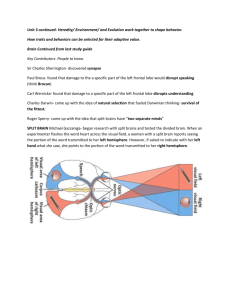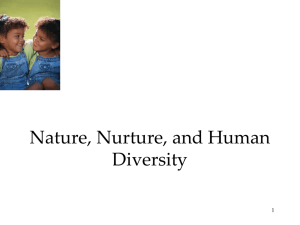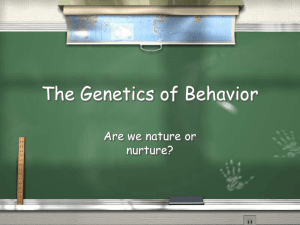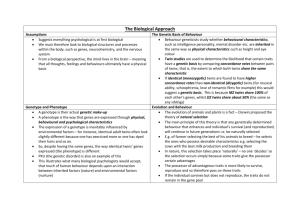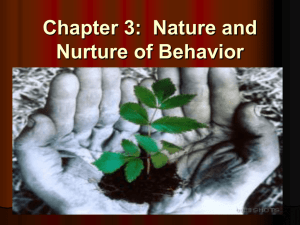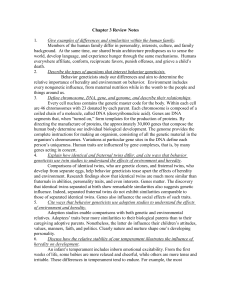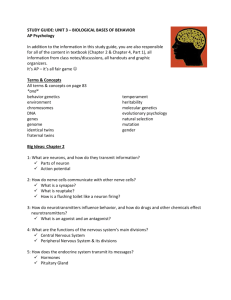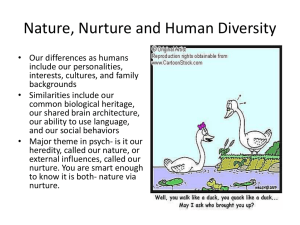File unit 3c fib - genetics & evolution
advertisement
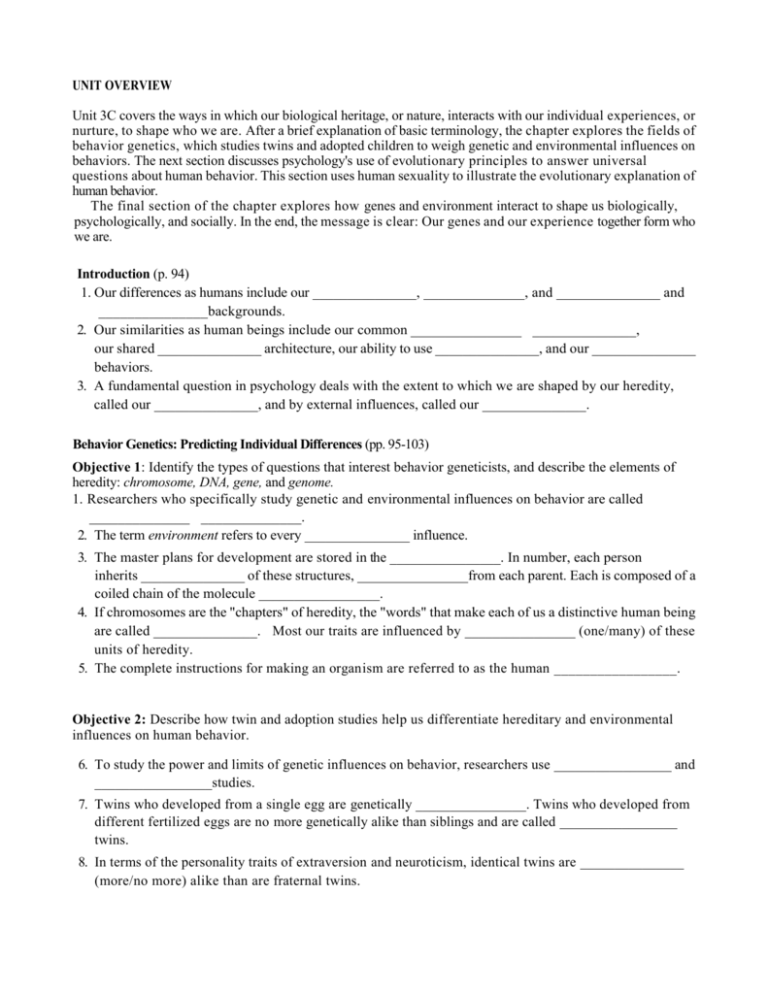
UNIT OVERVIEW Unit 3C covers the ways in which our biological heritage, or nature, interacts with our individual experiences, or nurture, to shape who we are. After a brief explanation of basic terminology, the chapter explores the fields of behavior genetics, which studies twins and adopted children to weigh genetic and environmental influences on behaviors. The next section discusses psychology's use of evolutionary principles to answer universal questions about human behavior. This section uses human sexuality to illustrate the evolutionary explanation of human behavior. The final section of the chapter explores how genes and environment interact to shape us biologically, psychologically, and socially. In the end, the message is clear: Our genes and our experience together form who we are. Introduction (p. 94) 1. Our differences as humans include our _______________, ______________, and _______________ and _______________backgrounds. 2. Our similarities as human beings include our common ________________ _______________, our shared _______________ architecture, our ability to use _______________, and our _______________ behaviors. 3. A fundamental question in psychology deals with the extent to which we are shaped by our heredity, called our _______________, and by external influences, called our _______________. Behavior Genetics: Predicting Individual Differences (pp. 95-103) Objective 1: Identify the types of questions that interest behavior geneticists, and describe the elements of heredity: chromosome, DNA, gene, and genome. 1. Researchers who specifically study genetic and environmental influences on behavior are called ______________ ______________. 2. The term environment refers to every _______________ influence. 3. The master plans for development are stored in the ________________. In number, each person inherits _______________ of these structures, ________________from each parent. Each is composed of a coiled chain of the molecule _________________. 4. If chromosomes are the "chapters" of heredity, the "words" that make each of us a distinctive human being are called _______________. Most our traits are influenced by ________________ (one/many) of these units of heredity. 5. The complete instructions for making an organism are referred to as the human _________________. Objective 2: Describe how twin and adoption studies help us differentiate hereditary and environmental influences on human behavior. 6. To study the power and limits of genetic influences on behavior, researchers use _________________ and _________________studies. 7. Twins who developed from a single egg are genetically ________________. Twins who developed from different fertilized eggs are no more genetically alike than siblings and are called _________________ twins. 8. In terms of the personality traits of extraversion and neuroticism, identical twins are _______________ (more/no more) alike than are fraternal twins. 9. Twin pairs reported ________________ (being treated alike/being treated differently). However, their similarities ________________ (could/could not) be attributed to how they were treated. 10. Through research on identical twins raised apart, psychologists are able to study the influence of the _________________. 11. Studies tend to show that the personalities of adopted children ______________ (do/do not) closely resemble those of their adoptive parents. However, adoption studies show that parenting ________________ (does/does not) matter. For example, many adopted children score ________________ (higher/lower) than their biological parents on intelligence tests. Objective 3: Explain what is meant by heritability, and give examples of the interaction of genes and environment on specific traits. 12. The extent to which variation among individuals can be attributed to differing genes is called _______________. Heritable individual differences _______________ (imply/do not necessarily imply) heritable group differences. 13. Genes are self- _________________; rather than acting as _________________ that always lead to the same result, they _________________ to the environmental context. 14. For _______________ phenomena, human differences are nearly always the result of both _______________and _______________ influences. 15. Throughout life, we are the product of the ________________of our ________________ predispositions and our surrounding _________________. 16. Environments trigger activity in ________________, and our genetically influenced traits evoke ________________ in other people. This may explain why _________________ twins recall greater variations in their early family life than do __________________ twins. Objective 4: Identify the potential uses of molecular genetics research. 17. The subfield of biology that seeks to identify some of the many genes that influence normal human traits is _______________ ________________. 18. To uncover the genes, researchers in this field seek links between certain _______________ or ________________ segments and specific disorders. They find families with the disorder over several generations, and they compare the ________________ of affected and unaffected members, looking for differences. Evolutionary Psychology: Understanding Human Nature (pp. 103-107) Objective 5: Describe the area of psychology that interests evolutionary psychologists, and point out some possible effects of natural selection in the development of human characteristics. 1. Researchers who study natural selection and the adaptive nature of human behavior are called ______________ ________________. 2. Researchers in this field focus mostly on what makes people so _______________ (much alike/different from one another). 3. According to the principle of _______________ ______________, traits that lead to increased reproduction and survival will be most likely to be passed on to succeeding generations. 4. Genetic ________________ are random errors in genetic replication that are the source of all genetic ________________. 5. Genetic constraints on human behavior are generally ________________ (tighter/looser) than those on animal behavior. The human species' ability to ________________ and therefore to ________________ in responding to different ________________ contributes to our ________________, defined as our ability to ________________ and _________________. Because of our genetic legacy, we love the tastes of sweets and _________________, which we tend to ________________, even though famine is unlikely in industrialized societies. Objective 6: Identify some gender differences in sexuality and mating preferences, and describe evolutionary explanations for those differences. 6. Compared with women, men are ______________ (equally/more/less) likely to desire more frequent sex, and they are ______________ (equally/more/less) likely to initiate sexual activity. This is an example of a ______________ difference. 7. The ________________ explanation of gender differences in attitudes toward sex is based on differences in the optimal strategy by which women and men pass on their _________________. According to this view, males and females ________________ (are/are not) selected for different patterns of sexuality. 8. Cross-cultural research reveals that men judge women as more attractive if they have a ________________ appearance, whereas women judge men who appear _________________, _______________, _________________, and ________________as more attractive. Objective 7: Summarize the criticisms of evolutionary explanations of human behaviors, and describe the evolutionary psychologists' responses to these criticisms. 9. Critics of the evolutionary explanation of the gender sexuality difference argue that it often works ________________ (forward/backward) to propose a ______________ explanation. 10. Another critique is that gender differences in sexuality vary with ________________ expectations. Gender differences in mate preferences are largest in cultures characterized by greater gender _______________ (equality/inequality). 11. Evolutionary psychologists counter the criticisms by noting that the sexes, having faced similar adaptive problems, are more ________________ (alike/different) than they are ________________ (alike/different). They also note that evolutionary principles offer testable _______________. Reflections on Nature and Nurture (pp. 108-110) Objective 8: Discuss some of the ways heredity and environment interact to both "control" who we are and allow us to become who we want to be. 1. As brute strength becomes _______________ (more/less) relevant to power and status, gender roles are _______________ (converging/diverging). 2. We are the product of both ________________ and ________________, but we are also a system that is ______________. We know this because a _______________ approach to development shows that no single factor is all-powerful. 3. The principle that we should prefer the simplest of competing explanations for a phenomenon is called _______________ ________________.
